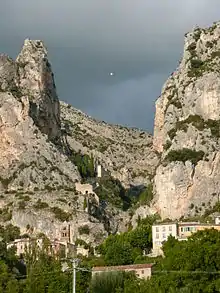Géologique de Haute-Provence National Nature Reserve
The Géologique de Haute-Provence National Nature Reserve (RNN73) is a national nature reserve in Provence-Alpes-Côte d'Azur. Established in 1984, it covers 269.316 hectares over 18 sites in the Alpes-de-Haute-Provence and Var. Located between the Verdon and Durance rivers, it is a labellised area for its landscape diversity, witness of the geological past of the Earth. It is the largest geological reserve in Europe.[1]
| Géologique de Haute-Provence National Nature Reserve | |
|---|---|
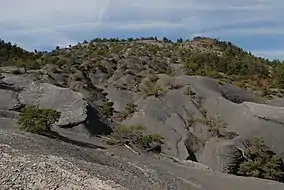 Marl of the Adret de l'Escure | |
| Location | Alpes-de-Haute-Provence and Var, France |
| Nearest city | Digne-les-Bains |
| Coordinates | 44°4′41″N 6°18′21″E |
| Area | 269 ha |
| Established | 31 October 1984 |
| Governing body | Departmental Council of Alpes-de-Haute-Provence |
| Haute-Provence Geologic Formation | |
|---|---|
| Stratigraphic range: | |
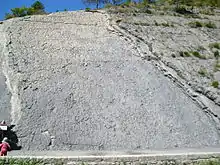 | |
| Type | Geologic formation |
| Location | |
| Coordinates | 44°4′41″N 6°18′21″E |
| Region | |
| Country | |
| Type section | |
| Named for | Haute-Provence |
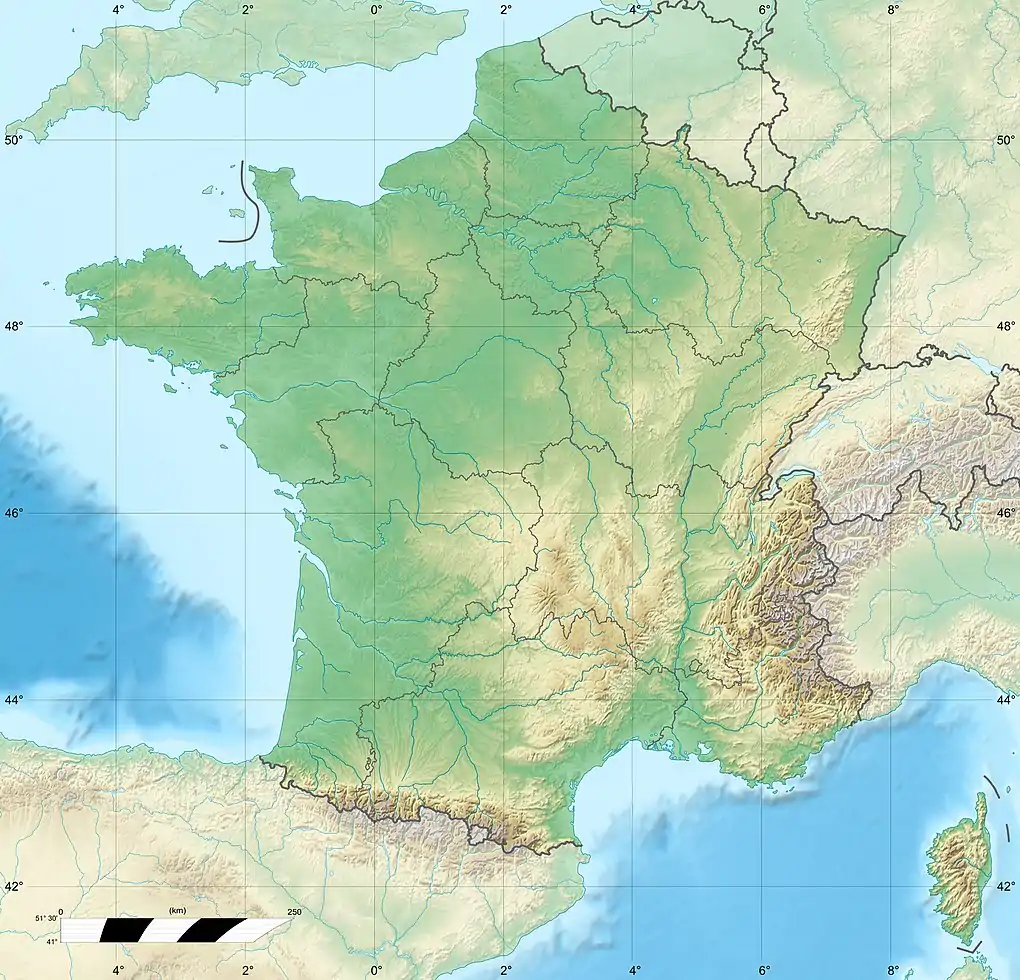 Géologique de Haute-Provence National Nature Reserve (France) | |
Location
The domain of the nature reserve spreads over 18 sites bearing fossils and outcrops with a cumulated area of 269.316 hectares, over the communes of Barles, Barrême, Chaudon-Norante, Clumanc, Digne-les-Bains, Entrages, Hautes-Duyes, La Javie, La Robine-sur-Galabre, Saint-Lions, Senez and Tartonne.
It is completed by a protection area[2] which regulates[3] fossil collections, spreading over 52 communes in the Alpes-de-Haute-Provence and 7 in Var. The total area of the protected area covers more than 2300 km2[4] and covers the communes of Aiglun, Angles, Archail, Authon, Auzet, Barles, Barras, Barrême, Beaujeu, Beynes, Blieux, Bras-d'Asse, Le Brusquet, Castellane, Le Castellard-Mélan, Le Chaffaut-Saint-Jurson, Champtercier, Châteauredon, Chaudon-Norante, Clumanc, Digne-les-Bains, Draix, Entrages, Estoublon, Hautes-Duyes, La Javie, Lambruisse, Majastres, Mallemoisson, Marcoux, Mézel, Mirabeau, Montclar, Moriez, Moustiers-Sainte-Marie, La Palud-sur-Verdon, Prads-Haute-Bléone, La Robine-sur-Galabre, Rougon, Saint-André-les-Alpes, Saint-Geniez, Saint-Jacques, Saint-Julien-d'Asse, Saint-Lions, Selonnet, Senez, Seyne-les-Alpes, Tartonne, Thoard, Verdaches, Vergons et Le Vernet in Alpes-de-Haute-Provence and Bargème, Brénon, Le Bourguet, Châteauvieux, Comps-sur-Artuby, La Martre and Trigance in Var.[5]
History of the site and reserve
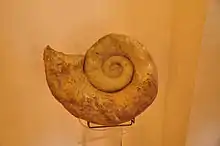
130 millions of years ago, giant ammonites more than one meter wide colonized the ocean that then covered ths area of the Préalpes.[6]
Geologic patrimony
Those fossils can be discovered either in the Musée Promenade at Digne-les-Bains, or in situ in the wrinkled and fractured layers of geological sites.[6]
The most famous site is the Dalle à ammonites, on the RP 900 at 1.5 km north of Digne-les-Bains. With a 60° incline, it bears over 1 500 ammonites, 90% of which belonging to the species Coroniceras multicostatum from the Sinemurian (Early Jurassic). Those ammonites could attain a diameter of 70 cm. Remains of nautilus, belemnites, Pecten and other bivalves can also be seen. The deposit thickness is estimated to be around 20 cm, laid over a 100 000-year period.[7]
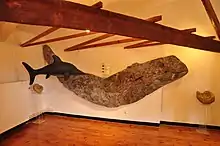
The La Robine ichthyosaur, showcased in the Digne museum, lived during the late Toarcian, 185 millions of years ago. This marine reptile was quickly buried, which limited its decomposition. Its conservation is due to paleogeographic conditions favouring the tilting of blocks, caused by the rifting following the opening of the Piemont-Liguria Ocean.[8]

At Castellane, the museum of the Maison Nature et Patrimoine allows to go back 40 millions of years ago. A warm sea covered then this part of the Alpes-de-Hautes-Provence and was populated with marine mammals such as sirenians.[9] Also known as sea cows, as they mostly eat algae and aquatic plants, they gave birth to the antic myth of the mermaids.[10]
- Ammonites from the geological reserve



Touristic and educational interest
The museum of Castellane, Sisteron and Digne-les-Bains offers marked discovery tours, accessible to anyone.
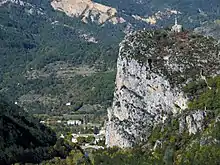 Roc de Castellane
Roc de Castellane Adret de l'Escure in Digne-les-Bains
Adret de l'Escure in Digne-les-Bains Montagne du Brouis in Bargème
Montagne du Brouis in Bargème
Administration, management plan, regulations
Once managed by the Association pour la gestion de la réserve géologique de Haute Provence, established in 1984,[4] the nature reserve is now under the gestion of the Departmental Council of Alpes-de-Haute-Provence.
Reglementations forbid collections and extractions of any fossils. The collection of naturally released fossils is tolerated, but only in limited quantities.[5] It is a UNESCO-labbelized area, affiliated with the Global Geoparks Network, and founding member of the European Geoparks Network.[4]
Tools and legal status
The nature reserve was established under decree of the 31 October 1984.[11]
References
- Muséum national d'Histoire naturelle (2003). "Région de Digne (FR3600073)". Inventaire national du Patrimoine naturel. Archived from the original on 18 July 2013. Retrieved 5 January 2014.
- "Arrêté préfectoral no 89-527 du 15 mars 1989 portant création d'un périmètre de protection autour de la RNN géologique de Haute-Provence" (PDF). Dreal PACA. Archived (PDF) from the original on 2019-06-06. Retrieved 2022-02-23.
- "Arrêté interpréfectoral réglementant le périmètre de protection autour de la RNN géologique de Haute-Provence" (PDF). Dreal PACA. Archived (PDF) from the original on 2019-06-06. Retrieved 2022-02-23.
- "Réserve géologique des Alpes, site de l'association pour la gestion". Archived from the original on 2013-10-01. Retrieved 2022-02-23.
- "Le territoire du site géologique". Archived from the original on 2015-02-17. Retrieved 2022-02-23.
- "Réserve naturelle géologique de Haute-Provence". Archived from the original on 2022-02-17. Retrieved 2022-02-23.
- "Analyse de Georges Henri Ducreux". Archived from the original on 2016-03-03. Retrieved 2022-02-23.
- "Circuit géodidactique du massif du Blayeul".
- "Musée des sirènes et des fossile à Castellane". Archived from the original on 2018-01-08. Retrieved 2022-02-23.
- "Musée des sirènes et des fossiles". Archived from the original on 2012-06-23. Retrieved 2022-02-23.
- "Décret n°84-983 du 31 octobre 1984 PORTANT CREATION DE LA RESERVE NATURELLE GEOLOGIQUE DE LA REGION DE DIGNE (ALPES-DE-HAUTE-PROVENCE)". Legifrance. Archived from the original on 2016-03-17. Retrieved 2022-02-23.
